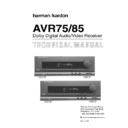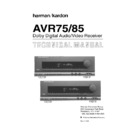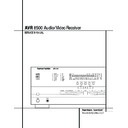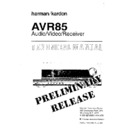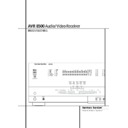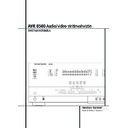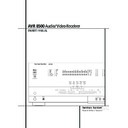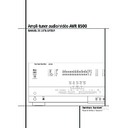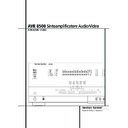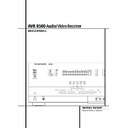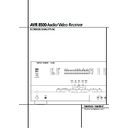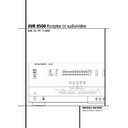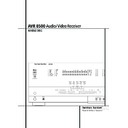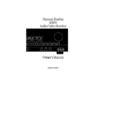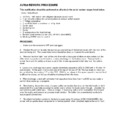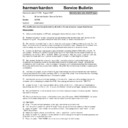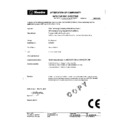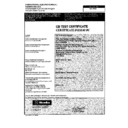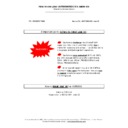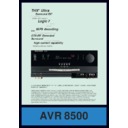Read Harman Kardon AVR 85 (serv.man3) Service Manual online
AVR75/85
Dolby Digital Audio/Video Receiver
Harman Consumer Group
250 Crossways Park Drive
Woodbury, N.Y. 11797
1-800 422-8026 in the USA
A Harman International Company
Rev A 12/99
TECHNICAL MANUAL
4
Harman Kardon
Dolby Digital Audio/Video Receiver
AVR75/85
ELECTROSTATICALLY SENSITIVE (ES) DEVICES
Some semiconductor (solid state) devices can be damaged easily by
static electricity. Such components commonly are called Electrostatically
Sensitive (ES) Devices. Examples of typical ES devices are integrated
circuits and some field effect transistors and semiconductor “chip”
components. The following techniques should be used to help reduce
the incidence of component damage caused by static electricity.
1. Immediately before handing and semiconductor component or
semiconductor-equipped assembly, drain off any electrostatic charge on
your body by touching a known earth ground. Alternatively, obtain and
wear a commercially available discharging wrist strap device, which
should be removed for potential shock reasons prior to applying power to
the unit under test.
2. After removing an electrical assembly equipped with ES devices, place
the assembly on a conductive surface such as aluminum foil, to prevent
electrostatic charge buildup or exposure of the assembly.
3. Use only a grounded-tip soldering iron to solder or unsolder ES
devices.
4. Use only a anti-static solder removal device. Some solder removal
devices not classified as “anti-static” can generate electrical charges
sufficient to damage ES devices.
5. Do not use freon-propelled chemicals. These can generate electrical
change sufficient to damage ES devices.
6. Do not remove a replacement ES device from its protective package
until immediately before you are ready to install it. (Most replacement ES
devices are packaged with leads electrically shorted together by
conductive foam, aluminum foil or comparable conductive material.)
7. Immediately before removing the protective material from the leads of
a replacement ES device, touch the protective material to the chassis or
circuit assembly into which the device will be installed.
CAUTION: Be sure no power is applied to the chassis or circuit, and
observe all other safety precautions.
8. Minimize bodily motions when handling unpackaged replacement ES
devices. (Otherwise harmless motion such as the brushing together or
your clothes fabric or the lifting of your foot from a carpeted floor can
generate static electricity sufficient to damage an ES device.)
LEAKAGE TEST
(FOR SERVICE ENGINEERS IN THE U.S.A.)
Before returning the unit to the user, preform the following safety checks:
1. Inspect all lead dress to make certain that leads are not pinched or that hardware is not lodged between parts in the unit.
2. Be sure that any protective devices such as nonmetallic control knobs, insulating fishpapers, cabinet backs, adjustment and compartment covers or
shields, isolation resistor-capacity networks, mechanical insulators, etc. which were removed for servicing are properly reinstalled.
3. Be sure that no shock hazard exists; check for leakage
current using Simpson Model 229 Leakage Tester, standard
equipment item No. 21641, RCA Model WT540A or use
alternate method as follows: Plug the power cord directly into
a 120-volt AC receptacle (do not use an Isolation
Transformer for this test). Using two clip leads, connect a
1500 Ohm, 10-watt resistor parallel by a 0.15
1500 Ohm, 10-watt resistor parallel by a 0.15
m
F capacitor, in
series with all exposed metal cabinet parts and a known
earth ground, such as a water pipe or conduit. Use a VTVM
or VOM with 1000 Ohms per volt, or higher sensitivity to
measure the AC voltage drop across the resister. (See
Diagram.) Move the resistor connection to each exposed
metal part having a return path to the chassis (antenna,
metal, cabinet, screw heads, knobs and control shafts,
escutcheon, etc.) and measure the AC voltage drop across
the resistor. (This test should be performed with the power
switch in both the On and Off positions.)
A reading of 0.35 volt RMS or more is excessive and
indicates a potential shock hazard which must be corrected
before returning the unit to the owner.
1 5
Harman Kardon
Dolby Digital Audio/Video Receiver
AVR75/85
View is upper left-hand corner of PCB
Bottom (trace) side
CONNECTION #1
CONNECTION #2
SERVICE AND ADJUSTMENT
I. SERVICE PROCEDURE
1.Tracking Point Memory
This service procedure can be used for measurement of the tuner circuit. With the POWER ON, press the “PRESET UP”
button while pressing the “MEMO” button for at least 3 seconds or more. FLD will display “TRACKING”. Frequencies to be
memorized are as follows:
VERSION
P1
P2
P3
P4
FM
US, Europe.
90.0
98.0
106.0
87.5
SCAN STEP
P5
P6
P7
P8
P9
P10
P11
P12~P30
AM
10 KHz
600.0
1000.0
1400.0
520.0
9 KHz
603.0
999.0
1404.0
531.0
MW/LW
171.0
207.0
270.0
152.0
531.0
2. FLD Segment Illumination
This service procedure will illuminate all segments by the following step: With the POWER ON, press the “FM/AM (TUNER)”
button while pressing the “MODE” button for at least 3 seconds or more. This procedure takes 1 minute and 40 seconds to
finish; at this point the procedure is complete.
Sequence
1. All segments will be illuminated for 5 seconds.
2. At the grid “1G”, segments are illuminated in the following order:
3. At the grid “2G” to “11G”, each segment is illuminated individually:
4. At the grid “12G”, segments are illuminated in the following order:
1 6
Harman Kardon
Dolby Digital Audio/Video Receiver
AVR75/85

